When I originally wrote on auxiliary ships, I started my tale at the dawn of the 20th century. Since then, I have learned of several earlier roots of the concept, to the point that it seemed worthwhile to write a prequel.
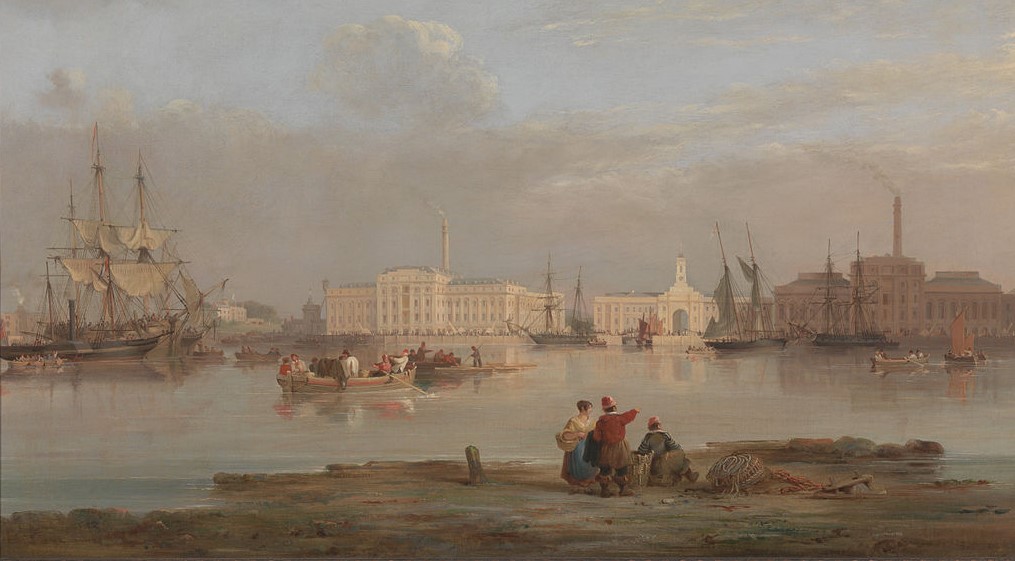
The Victualling Office at Plymouth
The US Navy is usually credited with the refinement of underway replenishment to give its fleet the ability to stay at sea for long periods, without the warships having to go into port for supplies. However, the first example I can find of a navy implementing a similar system dates to almost two centuries earlier. During its various wars with France, Britain inevitably attempted to blockade Brest, the main French naval port on the Atlantic. While the RN usually enjoyed significant numerical superiority, the French could choose their moment to sortie, making it imperative that the British keep as many ships on active service with the Western Squadron as possible.
Obviously, fuel, the great limit on warship endurance from the mid-1800s onward, wasn't a problem, but there were still restrictions on how long ships could usefully stay at sea. The staples of a sailor's diet, primarily biscuit and salted meat, could keep for a few years, and ships were routinely issued stores for 6 months.1 There were two major limitations to this, however. First, water stored in casks tended to go off after a few months. Second, foods that could be preserved were deficient in several important vitamins, most notably Vitamin C. Lack of Vitamin C causes scurvy, whose symptoms include bloody gums, irritability, fatigue, and poor healing of injuries. Scurvy was famously cured by issuing sailors a ration of citrus juice, first from lemons and them from limes,2 but that didn't happen until the 1790s. Before that, naval officers and physicians had many different theories about the causes and prevention of scurvy, one of which was the consumption of fresh vegetables.3
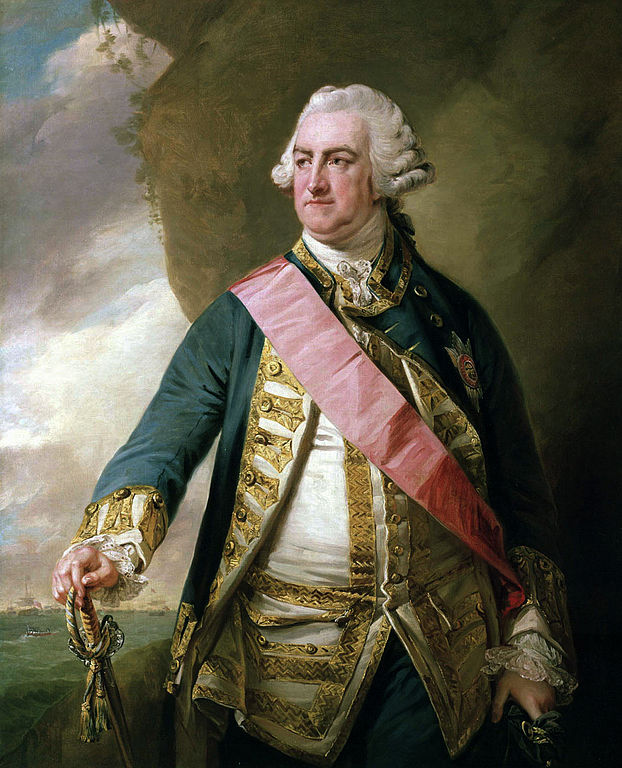
Edward Hawke
To deal with these problems, Admiral Edward Hawke, commander of the Western Squadron during the Seven Years War (1756-1763), set up a system in which chartered merchant transports, known as victuallers, brought out fresh provisions on a regular basis, transferring them to the blockading vessels at sea.4 This provided not only vegetables and water, but also fresh meat in the form of live bullocks that were butchered onboard the warships, usually over the course of several days, to supplement the salted beef and pork.5 Victuallers also provided a top-off of the standard provisions, and returned any that had gone bad to Plymouth, along with the hides of the bullocks, which would be turned into leather ashore. As a result of all this effort, the men of the squadron were said to be healthier after months on blockade than they would have been if left ashore, and the British maintained the blockade successfully, eventually destroying the French fleet at Quiberon Bay. In 1800, Admiral St. Vincent resurrected the system, and it, when combined with the lemon juice, worked so well that the hospital ship that had been dispatched to the blockading fleet was sent home as unneeded.
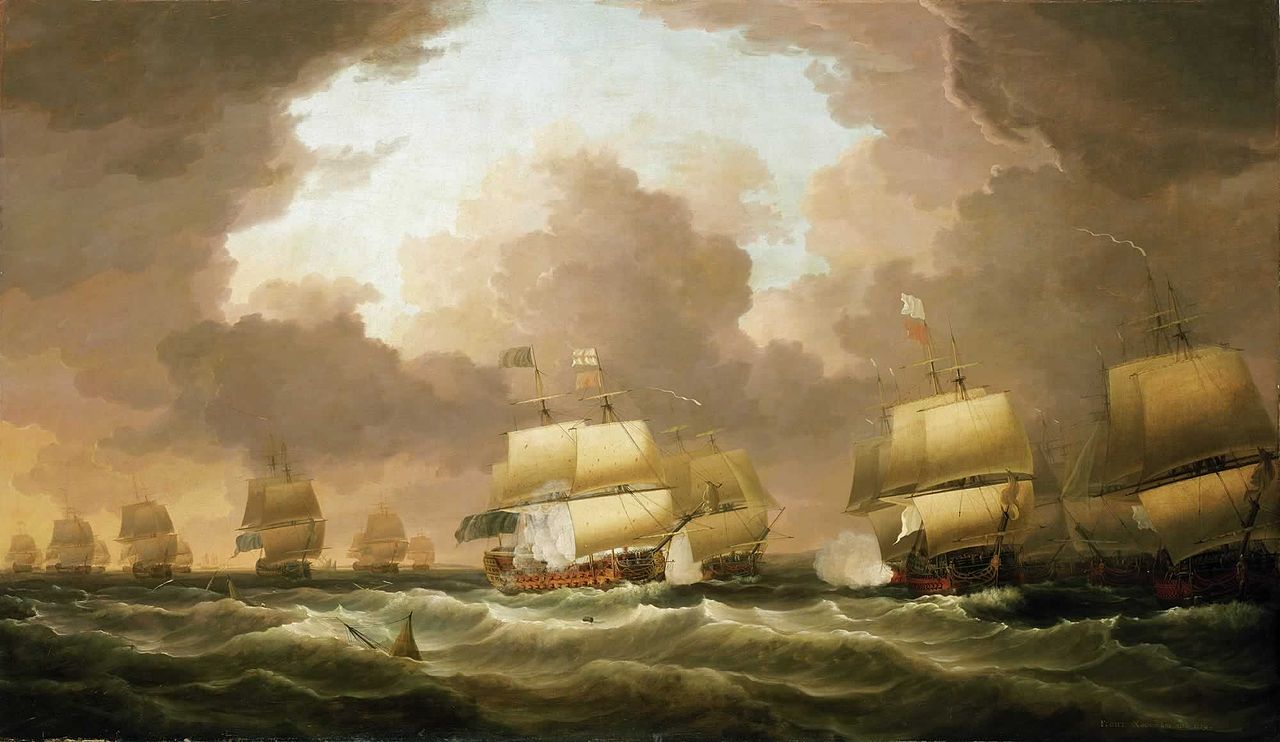
The Battle of Quiberon Bay
The age of sail also saw the precursor to the stationary auxiliary ships that would take the USN across the Pacific in the 20th century. Wooden ships would weaken as they age, and often were too fragile for service on the open sea long before they actually fell apart. Navies would routinely strip them of their rigging and convert them for harbor duties, a process known as hulking, with the results being known as hulks. The roles for hulks were many and varied. Most were simply used in place of buildings ashore, as they were essentially free to the Navy. Uses included powder and equipment storage, as well as holding people, everyone from convalescents to prisoners to students to newly impressed sailors and the crews of ships that were in dockyard hands. Another major advantage of hulks in these roles was that they were easy to guard, as most sailors couldn't swim, and would thus find it hard to desert. Some hulks were used for more exotic duties, such as the sheer hulks, fitted out as floating cranes and used for the vital task of erecting the lower masts of ships under construction or repair. Others were used as pontoons during salvage operations, providing buoyancy to lift sunken vessels and equipment.6
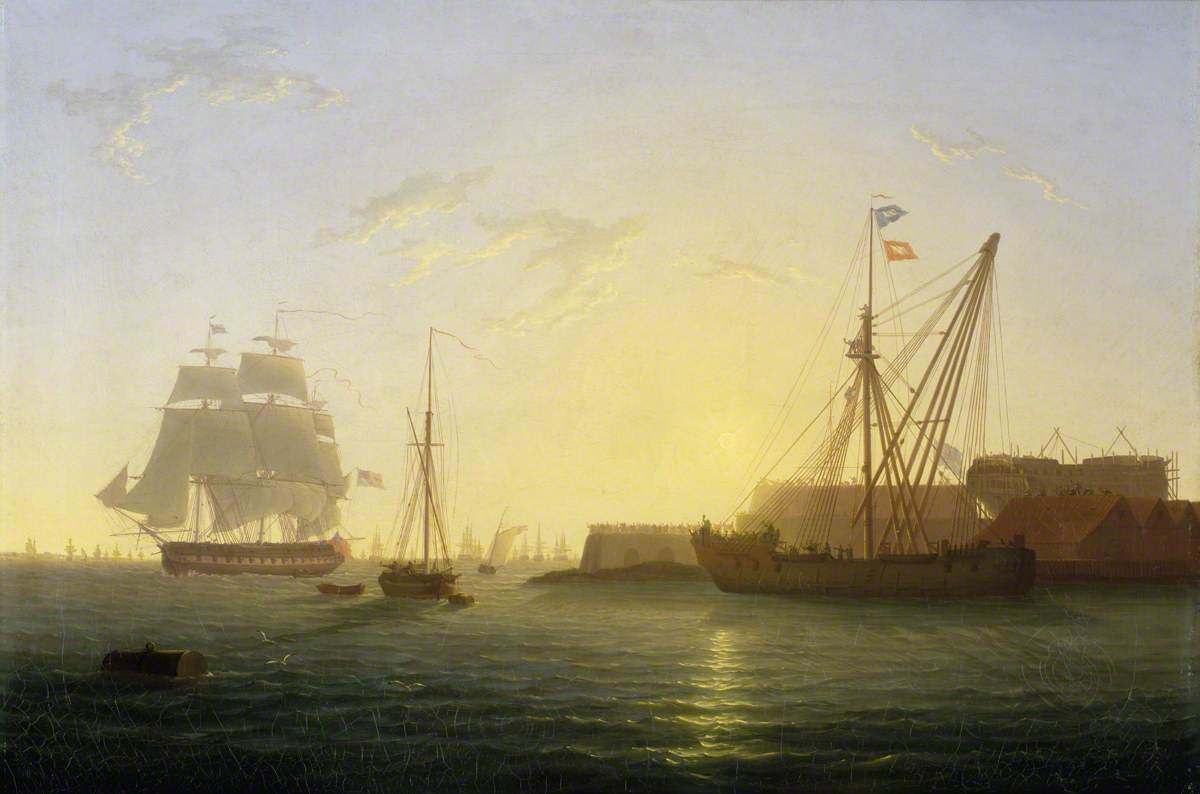
A sheer hulk awaits the arrival of a ship
The arrival of steam power posed new challenges, as early plants required a great deal of external support. This usually came from "steam factories" ashore, although experiments with afloat support began in 1837 when coal hulk HMS Ariadne, based at Alexandria, was given a forge and supplies for making temporary repairs to steam machinery. Nothing more was heard of the idea for a decade and a half, until 1851, when schooner HMS Spider was fitted out as a floating steam factory. Although she never ventured far from home, her successor, HMS Volcano, a steam paddler, played a vital role in sustaining the British fleet in the Baltic during the Crimean War. She was fitted with a cupola furnace capable of melting over 3,000 lb of metal at a time, four hearths for blacksmithing, an 800 lb steam hammer, two punching machines, a planer, five drilling machines, two lathes, and various other metalworking apparatus. 12 mechanics from the steam factory ashore would operate the equipment, bolstered by engineers from ships under repair to keep complement, and thus cost, down. In 1854, she spent two months in the Baltic, repairing several vessels, although the weight of the machinery severely affected her performance under both steam and sail.
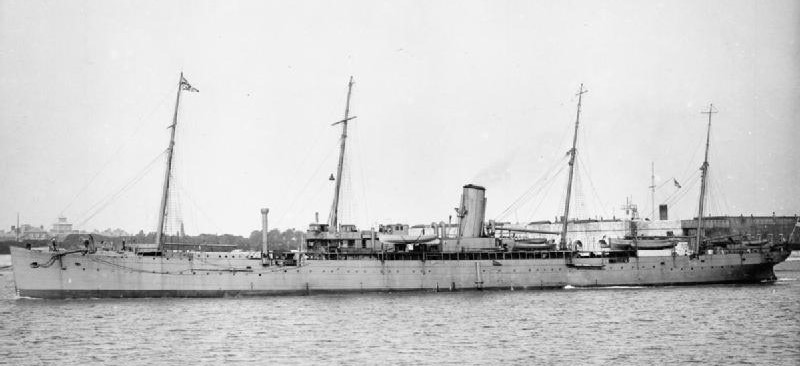
HMS Hecla, as I couldn't find any photos of Volcano
After modifications, she was sent back to the Baltic for 1855 and proved more successful, while other vessels were prepared to support the forces in the Black Sea. Two civilian steamers were purchased and named Bruiser and Abundance, and fitted out as a flour mill and bakery. Bruiser could grind 1120 lb of flour each hour, while Abundance produced almost 1.3 million lb of bread during the first 3 months of 1856. Another steamer, Chasseur, was modified to provide metal and wood components to the forces ashore. When the war had ended, Volcano was dispatched to Hong Kong to support the British forces fighting the Second Opium War. Her workshop was uninhabitable in the Chinese summer, and some of her equipment was put ashore for the Hong Kong Steam Factory before she returned home. After about 1860, improvements in steam engines reduced the need for floating factories, and the whole concept went away for 20 years. Even when it returned, it was in the form of the specialized torpedo boat tender Hecla, not a generalized repair ship. Hecla was followed by Vulcan, a purpose-built vessel intended to carry a number of smaller torpedo boats and deploy them into action. This wasn't particularly successful, and it wouldn't be until the 20th century that the RN, or any other navy, made another significant investment in repair ships.
During the 1880s, the RN again looked at building an auxiliary force to support blockade operations. As they didn't expect to be able to coal at sea, they would have had to find sheltered water nearby to transfer coal and supplies in, and the plan fizzled out. But the idea of coaling at sea didn't, as it was greatly desired to extend the relatively short range of coal-powered vessels. The British generally solved this problem with a near-monopoly over the world's supply of steam coal and colliers, and a worldwide network of coaling stations. The Americans had no such advantages, and during the Spanish-American War were forced to buy coal from the British in the Far East. In the Caribbean, things were slightly better, but lack of coal briefly forced the blockade of Santiago to be abandoned, and later lead to the Americans landing at Guantanamo to capture a sheltered coaling port, and the battleship Massachusetts missed Santiago altogether as she was coaling. Early efforts to coal at sea had been made, but all were rendered impractical by some combination of requirements for calm weather, low transfer rates, and the need to stop the ships entirely.7

An 1899 Miller trial with the armored cruiser New York
It was quickly obvious to everyone involved that any system of transferring coal between ships at sea would require some form of cable, as any scheme involving more substantial connections would be unable to cope with the relative movement of the two ships in any kind of seaway. The first trials of this type were conducted by the French, using an overhead crane running along a cable between two ships, but the first system to have even a pretense of operational capability was the Miller system, which involved the collier being towed by a warship and passing bags of coal along a line whose tension was provided by a sea anchor. A winch on the collier would haul the bags in or out, as needed. An initial trial with Massachusetts in 1899 proved reasonably successful, with an average transfer rate of about 20 tons an hour. Further improvements, most notably the replacement of the sea anchor with a slipping winch to improve the capacity of the line, were made, bringing the typical rate up to 40 tons/hour or more, and several of the USN's colliers were fitted with the equipment.8
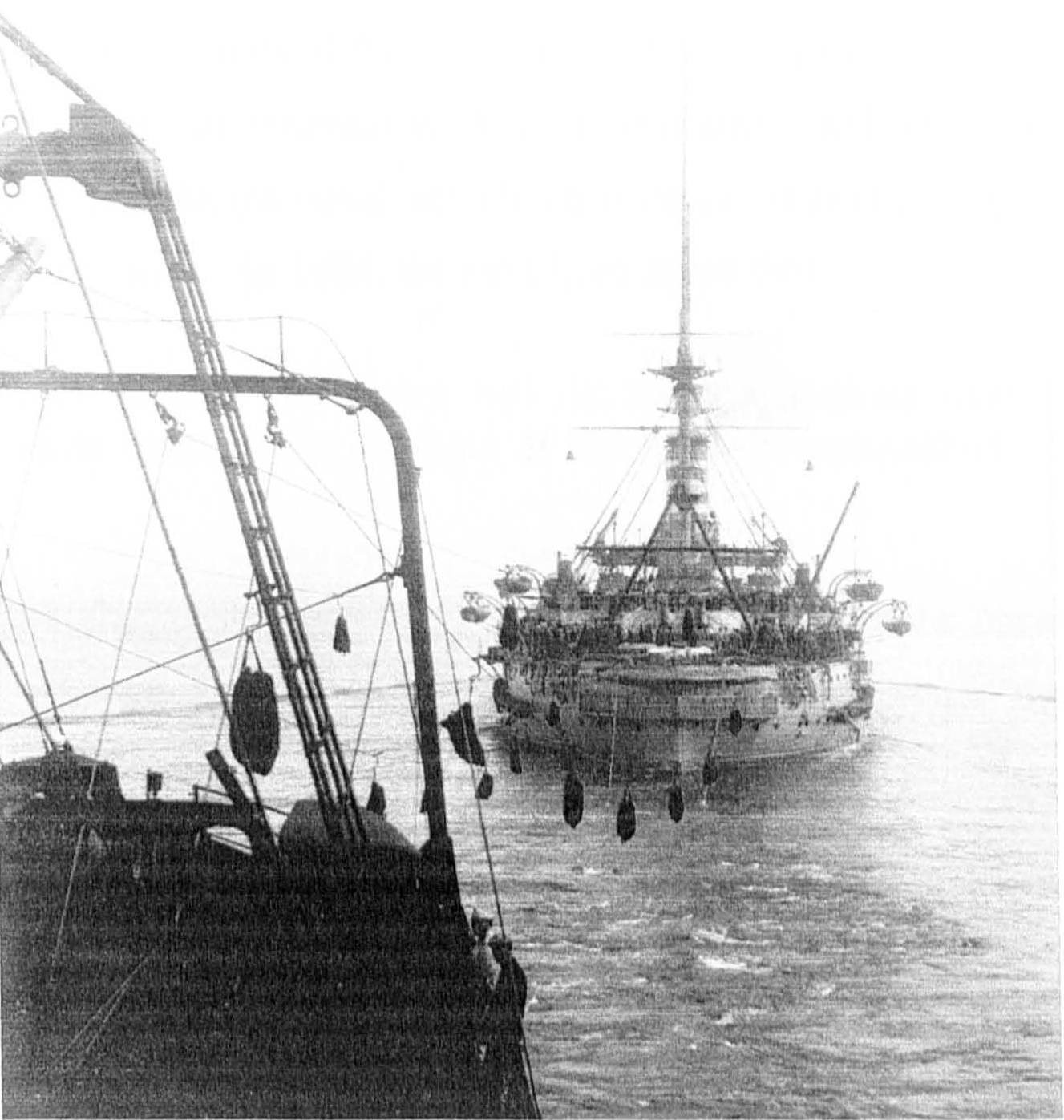
A 1906 trial of the Metcalf system
The RN also trialed the system, but it found the transfer rate unsatisfactory. To make matters worse, the chartered colliers it usually used took manpower from the receiving ship to load bags, obviously unavailable in an unrep situation, and couldn't be expected to carry lots of specialized equipment in peacetime. Despite these problems, the RN investigated several other systems, coming closest to adopting the so-called Metcalf system, which involved astern towing similar to that used in the Miller system, but with a steam ram to keep tension and a pair of endless loops carrying bags back and forth. This allowed transfer rates of 80 tons per hour or so, although this still wasn't enough to convince the RN to buy more than a single set of the equipment.910
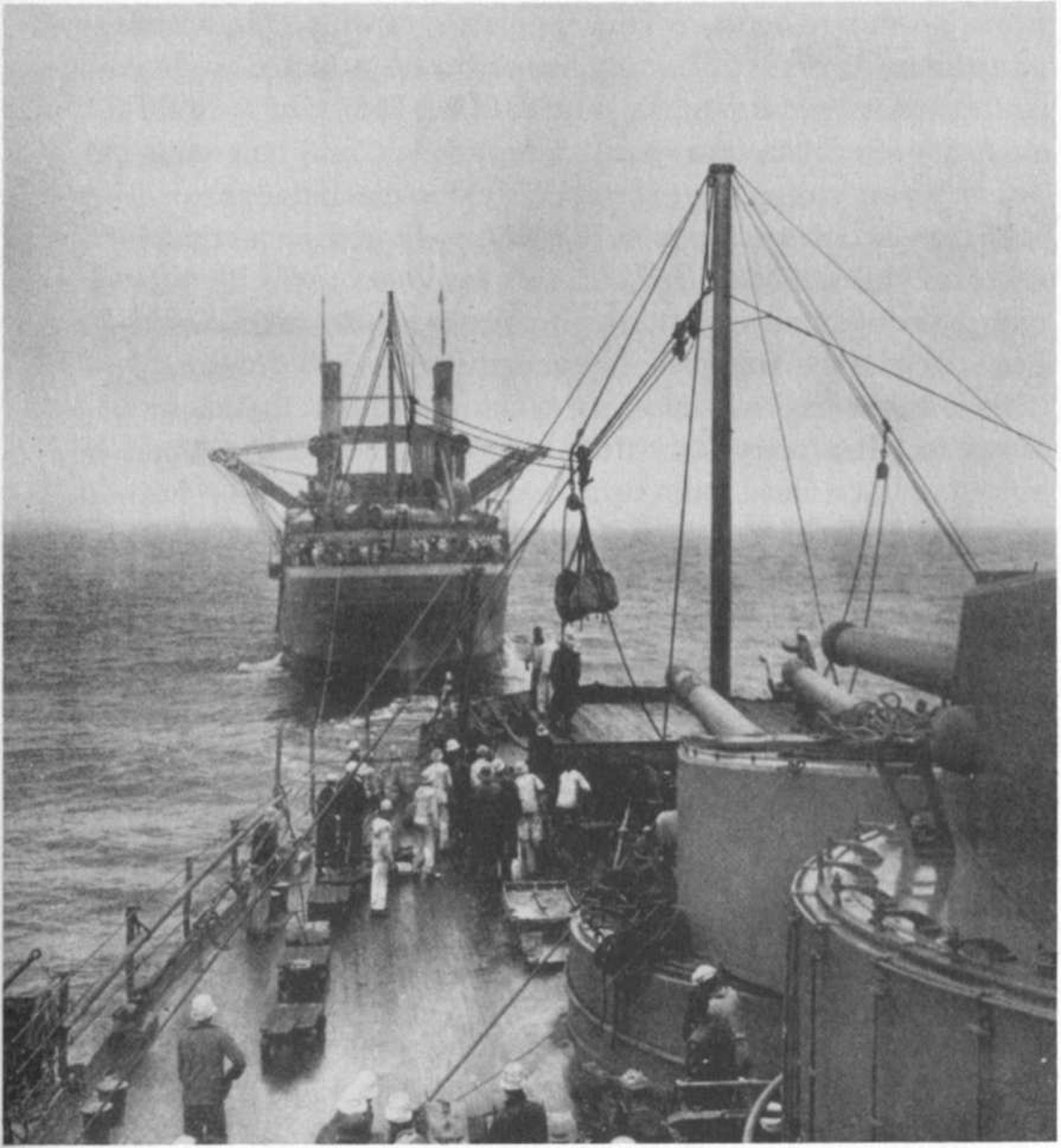
A late coaling-at-sea trial with the Miller system onboard South Carolina
In the end, the USN continued to experiment with coaling at sea the longest of any of the major navies, but none of these systems were used operationally. Instead, that would fall to Chester Nimitz and the Maumee, who transferred oil at sea and ultimately would revolutionize how naval forces operated.
1 Despite the popular image of the sailor's diet from the age of sail, the RN actually fed its crews quite well, given the limitations of the era. Most of the horror stories probably emerged from merchant shipping, which had none of the RN's controls. ⇑
2 This is the origin of the term "Limey", although the lime juice served after the Napoleonic Wars was actually processed in a way that destroyed most of the Vitamin C. It mattered less at that point, as steam and shorter sailing routes prevented most scurvy. ⇑
3 This one actually worked. A lot of the others focused on hygiene and regular exercise, which didn't. ⇑
4 I am not 100% sure how this was done, but I suspect that both vessels would lie to and transfer the supplies via boat. Some of the smaller victuallers may have come alongside directly, but doing something like modern UNREP with sailing ships seems impractical. ⇑
5 I wasn't able to find details on how these were transported, although my best guess is that they would use boats and a sling under the animal's belly. In any case it was undoubtedly a very tricky operation. ⇑
6 Hulks proved to be a great boon to future students of naval history, as this duty preserved many of the world's most important museum ships, such as USS Constitution, USS Constellation, HMS Victory, HMS Warrior and HMS Caroline, all of which survived as hulks until they were recognized as worthy of preservation. ⇑
7 My primary source for this section has an amusing account of the discussion of an 1883 paper on coaling at sea, where one commenter said the problem would be solved by the adoption of oil fuel, and another suggested a return to sails as a main method of propulsion. ⇑
8 To put this into perspective, a typical pre-dreadnought like Majestic had a peacetime coal capacity of 900 tons, and a wartime capacity of 1,900 tons, and burned 250 tons/day at full power and 50 tons/day at her economical speed of 8 kts, which might be typical on a blockade. In practical terms, this means that such a ship would need something like 5 hours of coaling every 4 days to keep herself topped off, which could give a worthwhile boost in a blockade scenario. Dreadnought, on the other hand, required 100 tons/day at 12.9 kts, and even more if she went slower. This means that you now need 5 hours every 2 days, which probably did a lot to dampen enthusiasm for coaling at sea. ⇑
9 There were a number of systems that were broadly equivalent to the Metcalf system trialed, but none proved notably superior. One proposal was for broadside replenishment, but it appears to have fallen victim to a prejudice similar to that which hindered broadside refueling of larger vessels in the interwar years. ⇑
10 The RN also experimented with astern replenishment of oil in this era, using the so-called "stirrup" system, where a metallic hose was suspended from the towing hawser with the stirrups, which had to be manually attached and detached as the hose was reeled in or out. This was extremely dangerous, and the hose had a tendency to burst, so the idea was abandoned until WWII. ⇑

Comments
Unless my understanding of naval provisioning is completely off, HMS Bruiser should be a flour mill, not a flower mill.
You would be correct on that.
In the next-to-last sentence, it looks like either the "while" or the "but" are extraneous. Also, I suspect there's a typo in the description of HMS Volcano's equipment, and that she was fitted with four hearths as opposed to fitted for hearths.
As to Note #5, my assumption is that they would have lifted the animals on a sling ("livestock sling" is the relevant Google search term) and then swung them from ship to ship. But it's entirely possible that they had a cleverer method, since a lot of people had a lot of time to think about the question and a lot riding on the answer.
The practise of using old ships as hulks is responsible for the preservation of quite a lot of old sailing ships- USS Constitution and Constellation and HMS Victory and Warrior were used as hulks for various purposes until people decided they were worth restoring and preserving. Warrior was in use as a fuel oil jetty until the late 1970s.
Possibly the newest ship to have ended up preserved like this is the light cruiser HMS Caroline, the last survivor of Jutland, which was used as a base for the Royal Naval Reserve in Belfast- the Belfast unit was the last RNR unit to move to a base ashore, possibly for security reasons, and Caroline became a museum ship in 2011.
@Bean,
When you say that coal transfer could provide, 20, 40 up to 80 tonnes per hour: just how much were they trying to transfer?
80 tph when you need 400 tonnes is a major imposition. If you need 4000 tonnes it's ridiculous.
Is it Helca or Hecla?
Predreadnoughts like the Canopus class carried about 900 tons of coal in peacetime and up to double in wartime. 80 tons would be a meaningful quantity to extend the range by a little, but to fully recoal at sea would take the better part of a day.
Thanks, all. Good points, and I've edited the post to include them, as well as some further thoughts about coal consumption.
Main/Dreadnought|Dreadnought, on the other hand, required 100 tons/day at 12.9 kts, and even more if she went slower.
Shouldn't that be if she went FASTER?
Actually no. At 10 kts, two sources lists coal (Burt and Roberts) list consumption as 127 tons/day. Turbines were very inefficient at low speeds.
The link to the Dreadnought article in footnote 8 is broken.
Fixed now. Man, this has not been a good post for my proofreading.